

Ying Mu
Corporate Branding Team
Social Web Marketing in China: How brands are using Sina Weibo
Since the popularity of Facebook, Twitter and Youtube have grown dramatically over the past few years, there have been volumes of discussions about the influence of social web marketing for brands. In China, the buzz now is Sina Weibo. “Weibo” is a semantic translation of “micro-blog” and follows the same basic structure as Twitter but with several differentiating features.
Founded in 2009, Sina Weibo is the largest micro-blogging site in China with more than 200 million users and growing. In this ultracompetitive market, Sina Weibo hosts more than 5,000 verified companies and 2,700 media organizations. This article takes a look at the potential of the platform as well as some of the implications of Sina Weibo for brands and social web marketing.
Sina Weibo, often referred to as “Chinese Twitter”, offers more in terms of content, structure and customization than its American counterpart. The following table illustrates some significant differences between Sina Weibo and Twitter.
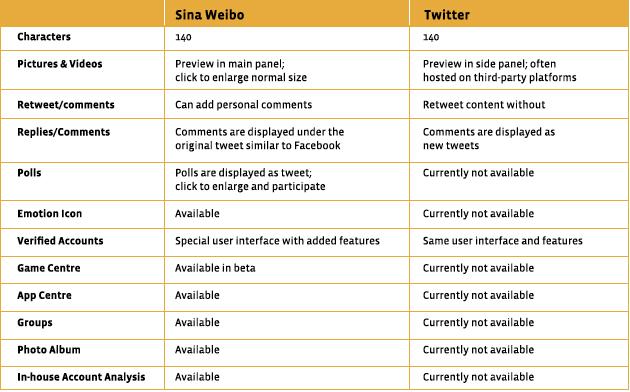
Aside from the technical functions, user habits also differ; HP Research Centre found that Sina Weibo users share and comment more about entertainment whereas Twitter users focus on news.
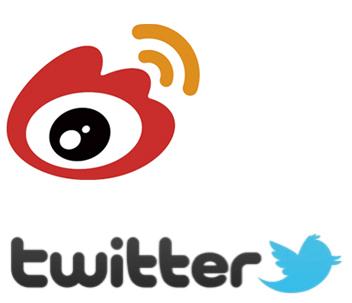
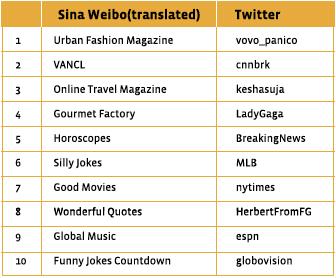
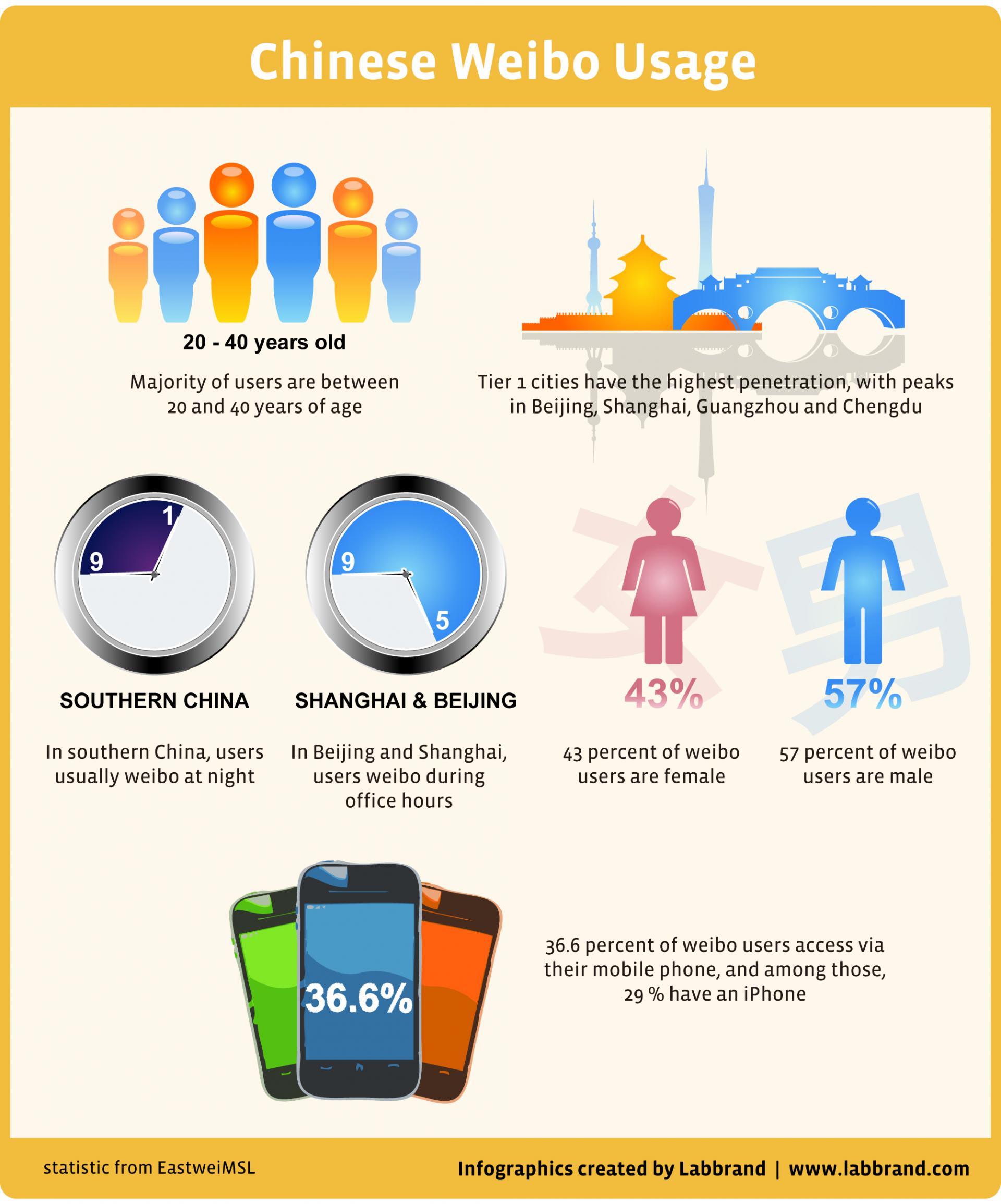
Internet culture is important and prominent in China. Many internet novels have been published and adapted into dramas or movies. As seen in the West, news that breaks out online will also be heavily discussed on other media channels. Experts have pointed out that Weibo has effectively merged the social networking characteristics of SNS; the convenience and immediacy of instant messaging; the individual touch of blogs; and the variety of subjects of BBS. With this growing trend, how can brands utilize this unique opportunity?
Consumer Insights
Most comments and tweets posted on Weibo reflect the user’s personal perception and experience. It is no wonder that companies are now using social media, especially micro-blogs, to gather consumer insights and monitor consumers’ perception of brands. This allows brands to capture current market information and perform checks for their brand positioning.
Furthermore, regularly checking competitors’ social media activities is also useful. As an ancient Chinese proverb states, “know the enemy, know yourself, and in every battle you will be victorious ”. Contents generated by consumers will reflect a competitor’s strength and weakness, which could lead to possible opportunities.
Social Web Marketing – Brand Awareness
There is no doubt that brand awareness is crucial to sustain the growth of a brand. Weibo supports a wide platform of different embedded media including videos, images, music, and emoticons. Many consider Weibo to be a relatively inexpensive method to improve brand awareness. However, it is not to say that brands will achieve that goal completely for free. Quality content and influential followers takes time and money to build. Social marketing research and influence tracking will also play an important role.
Integrated Interaction
Before the mega wave of new media hit, traditional media, such as television, offered one-way communication to a large number of audiences. Weibo is a two-way communication channel which relies on direct interaction. The buzz expression now is “engagement”. Why do brands engage in interactive conversations? One important factor is the nature of the platform; brands need the constant exchange of information between users. Also, information travels extremely fast on Weibo and it is hard to control. Interactions between users help brands to notify signs of negative content and utilize the platform as a customer service tool. (Read more here)
Labbrand analyses brand equity in terms of four pillars: differentiation, relevance, esteem, and knowledge. Differentiation represents a brand’s ability to stand apart from others while relevance is a measurement of appropriateness. Esteem indicates the degree to which the target audiences regard and respect a brand while knowledge identifies whether there is a true understanding of what a brand stands for. (Four Brand Equity Pillars)
We will call on several examples of brands on Weibo to illustrate how its use can affect the four pillars of brand equity, as well as discuss the branding implications.
Burberry
Burberry’s Weibo page has a very coherent style and visual identity. The grey colour tone is consistently applied to its side bar and text. The center has a short video clip which showcases the latest collection with links to other social media platforms on the side.
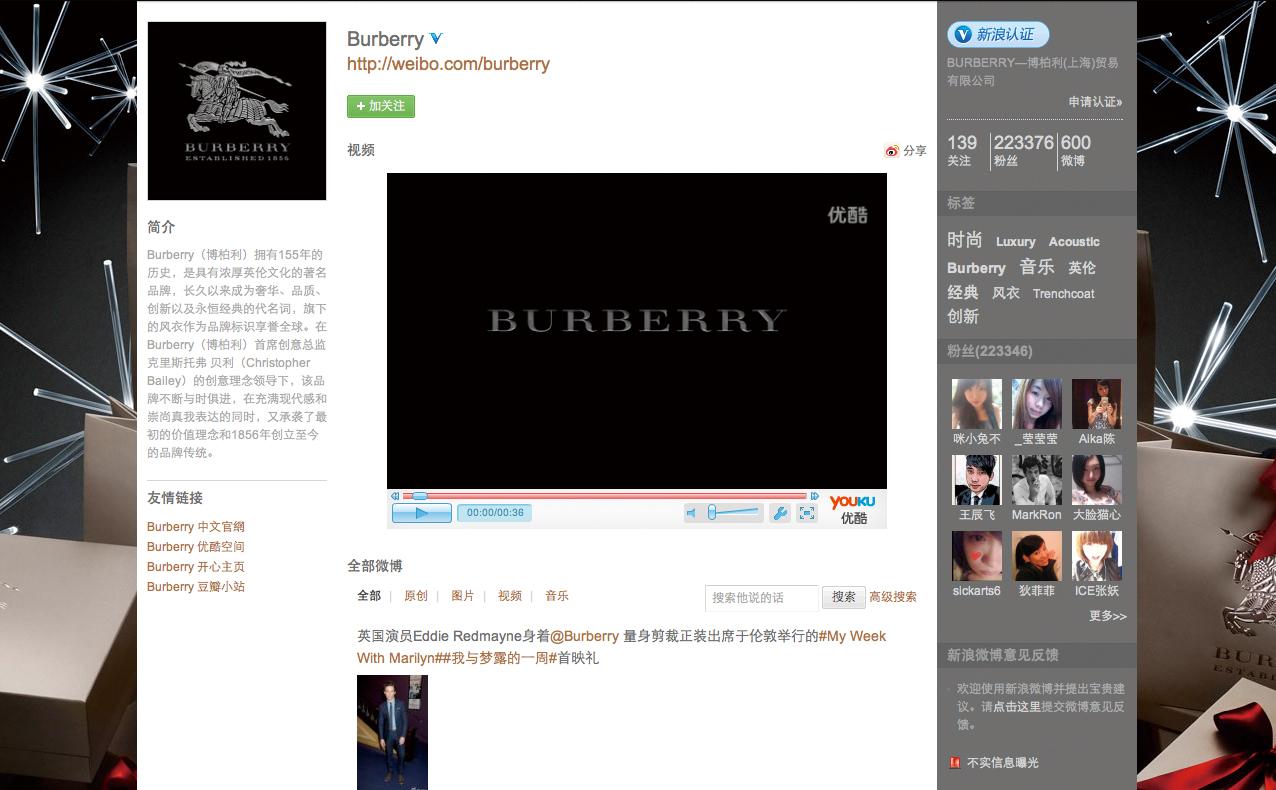
Burberry is one of the many luxury brands who currently incorporate Weibo in their branding strategy. While it has a relatively strong differentiation in the marketplace, Burberry’s Weibo platform does not have a unique differentiation point from other luxury goods competitors. Whether Weibo will strengthen Burberry’s differentiation is still questionable. Luxury brands inherently have a lower relevance than others due to its exclusivity and price. Burberry usually posts one to two tweets each day and the topics are only about its products or marketing campaigns. As demonstrated earlier, Weibo users tend to favour entertainment content. While Burberry’s update schedule will not cause irritation to its followers, the amount of content that could be retweeted or commented on is limited. This then might not increase the relevance of the brand to its consumers. Because the contents and visual identity are much aligned with Burberry’s brand image, followers’ regard for the brand remains consistent. Burberry’s utilization of Weibo improved followers’ understanding and knowledge of the brand as it constantly reinforces key brand ideas and the long history of Burberry. Although Weibo helped in terms of brand knowledge, its influence on the other pillars of brand equity remains questionable.
Social Web Marketing – VANCL
VANCL is an inexpensive Chinese clothing brand which operates solely online with no physical stores. Thus, Weibo is one of their main portals to build their brand.
VANCL has special campaigns which integrated offline communication with Weibo to create high response rates and eventually resulted in forming an online writing style called “Vancl”.
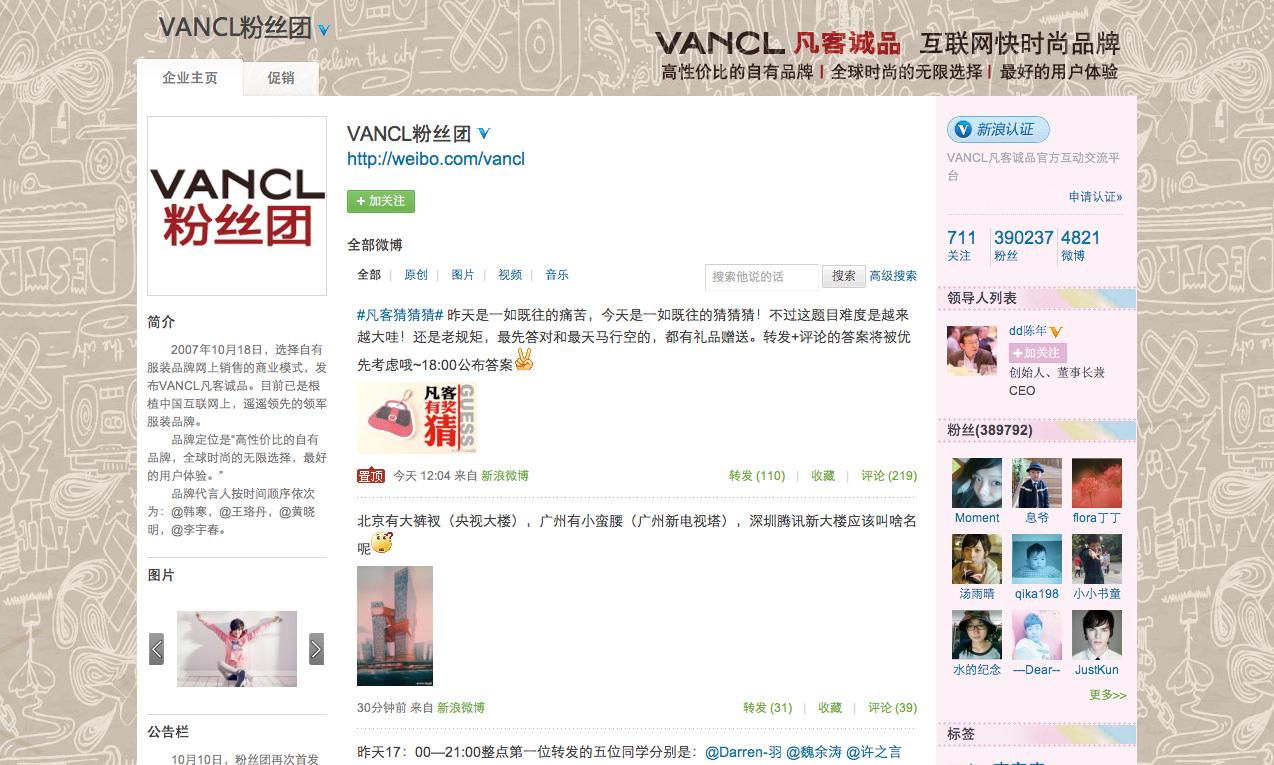
The brand was able to successfully differentiate from others through the use of Weibo. VANCL often retweets and engages in conversations. The brand has high relevance and continues to build relationships. Although the content and campaigns are liked by many, their brand esteem remains questionable due to the quality of their products. Knowledge of the brand improved through the campaign. Overall, Weibo helped VANCL to build its brand; however, brand esteem needs to be further enhanced.
Ikea
Ikea differentiated its brand by effectively utilizing a combination of Weibo functions to communicate with its audience. Aside from the feature video, Ikea engages in poll discussions and often retweets users’ contents with pictures of Ikea products. These practices not only increased the relevance of their products, but also increased consumers’ regard for the brand. Their poll was not focused on selling products or gathering direct consumer preferences; the most recent poll was titled “What is the most romantic thing you’ve done?”. Ikea also enabled a message board on the bottom of their page. When a customer complains about customer service or product defects, Ikea replies and solves the issue. Through these initiatives, Ikea’s Weibo page successfully strengthens their brand equity across all pillars.
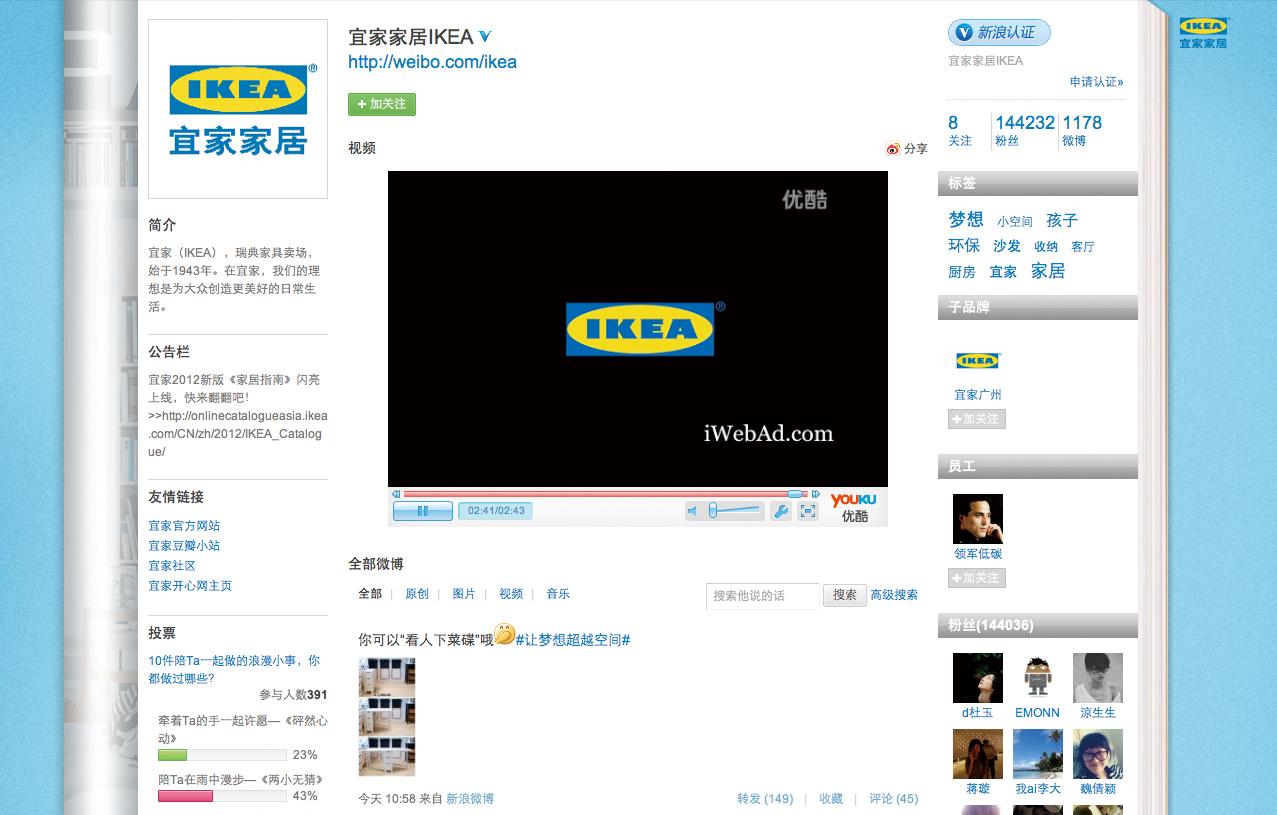
The digital age brings in new opportunities and challenges. Weibo is growing in terms of active users and continuously adding new features. It is not to say that all brands should be present on Sina Weibo, but they should at least be aware of its features, uses, and implications. While the use of new media is important, brands need to assess the relevance of the new media channel in relation to their overall brand strategy, as well as to monitor their influence over time. A brand’s true influence is not the amount of people who follow it but rather how deeply it can impact others. Social marketing research will continue to become more significant to the implementation of branding strategy. Although questions still remain on how brands can effectively use Sina Weibo, it is still a potential platform brands can utilize to further develop their brand equity.
A Labbrand Group Company © 2005-2024 Labbrand All rights reserved
沪ICP备17001253号-3* Will be used in accordance with our Privacy Policy
To improve your experience, we use cookies to provide social media features, offer you content that targets your particular interests, and analyse the performance of our advertising campaigns. By clicking on “Accept” you consent to all cookies. You also have the option to click “Reject” to limit the use of certain types of cookies. Please be aware that rejecting cookies may affect your website browsing experience and limit the use of some personalised features.